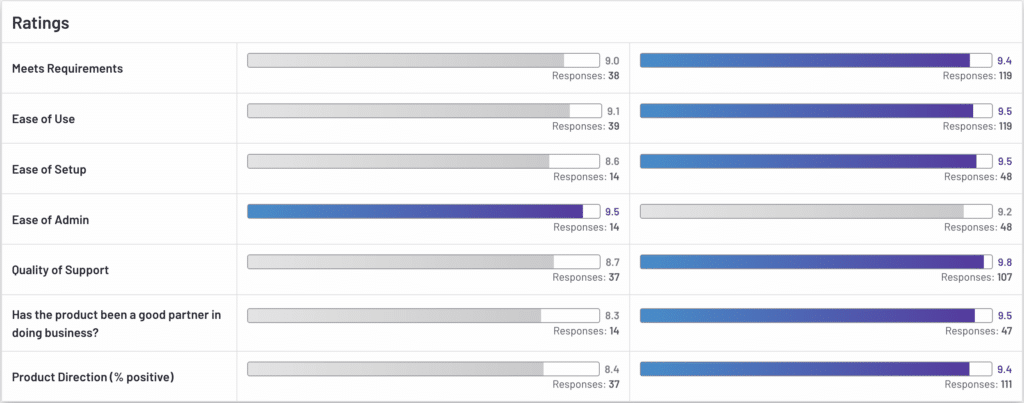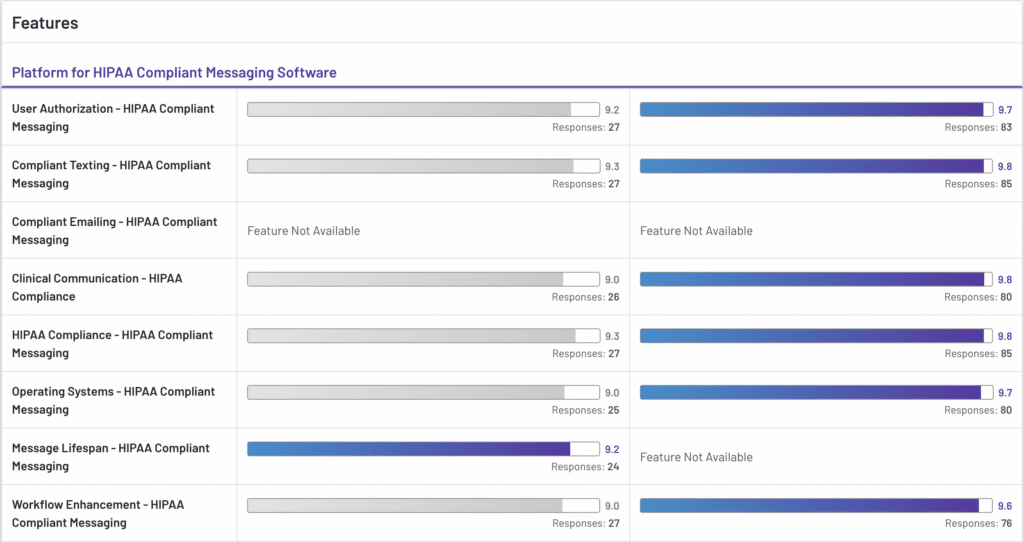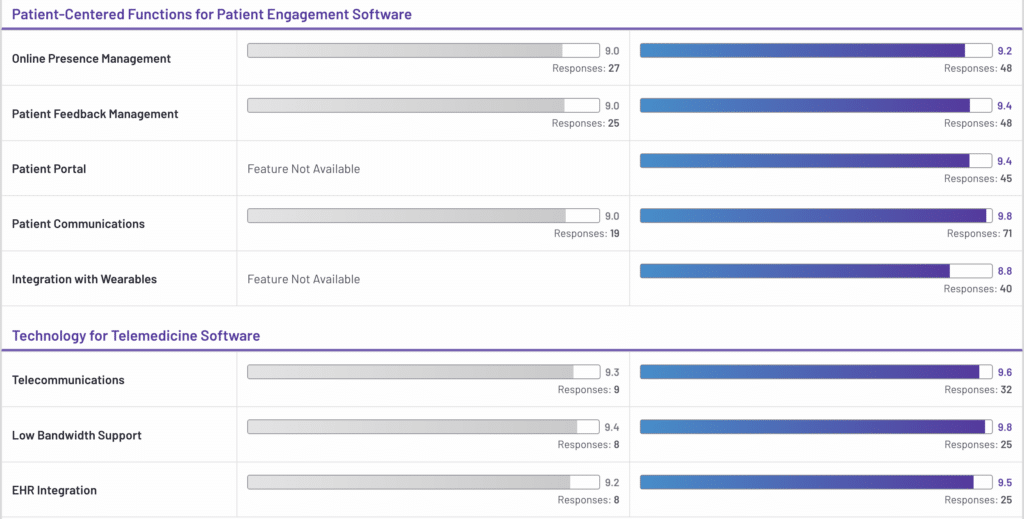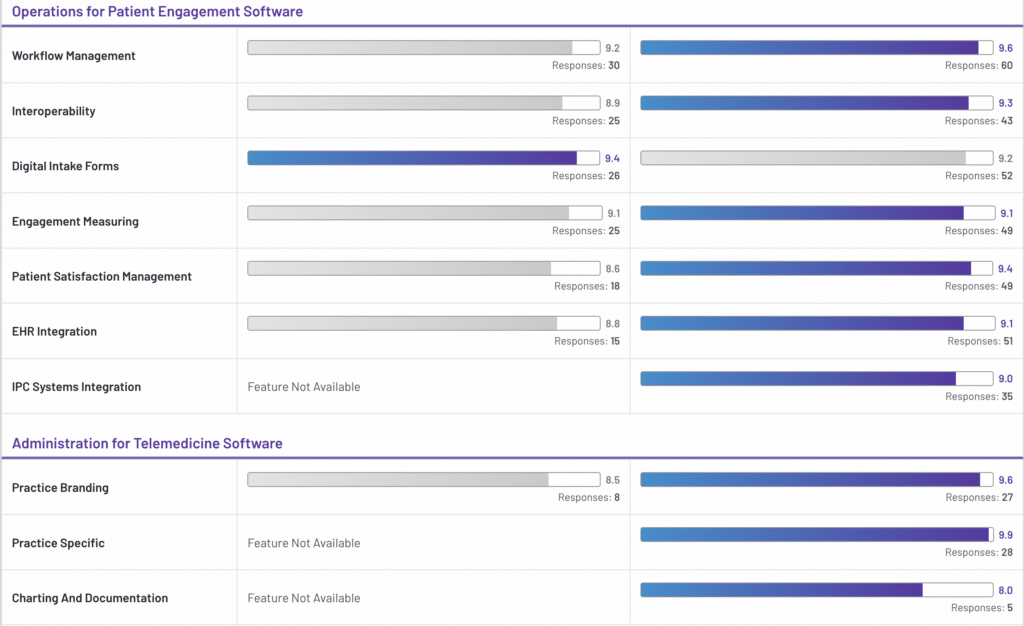
Turn Every Patient Call Into A Text and Save 3 Hours Every Day.
Looking to solve the call volume challenge and deliver a delightful patient experience? Try OhMD for free for two weeks.

When you are researching your options for patient communication platforms you’ve likely plugged terms like “Klara pricing” into your search engine with varying success in finding what you’re looking for. Here we’ll break down the Klara vs. OhMD comparison including pricing information to help you make an informed decision.


Keep scrolling to see how OhMD and Klara customers score each product!

Looking to solve the call volume challenge and deliver a delightful patient experience? Try OhMD for free for two weeks.
Update: The best way to compare OhMD and Klara is by reading user feedback and product scores on the independent third-party software review website, G2.com (see below).



The cost of a solution is always one of the things you have to consider when making a decision as a healthcare provider. The key there though is it should truly be only one of the things you think about.
And we would argue not the most important one.
One of the things people find in common when they look up Klara pricing and compare it with OhMD is that both solutions are well regarded. Just look up Klara reviews and OhMD reviews. Both platforms have a variety of features and benefits.
You search for Klara pricing, Klara reviews, Klara features, Klara integrations, Klara app or Klara whatever-you-may-be-wondering-about. Then you do the same search for OhMD. What you’re really trying to understand is whether or not the tool fits your requirements and business needs.
When the tools you are considering offer similar functionality, what is usually helpful is to understand what sets them apart from each other.
The easiest way to understand the difference between Klara and OhMD? Think about the problem they are each trying to solve.
On the face of it, yes, both are working to solve the problem of open communication between doctors and patients so clinicians can offer better treatment. Digging deeper it becomes more clear where each solution’s focus lies.
We can break this down pretty easily.
Start with the best patient experience.
What we mean by that is that we, at OhMD, believe the key to incredible healthcare communication is to understand and solve for the core issues patients face when communicating with their doctor first, building tools that are incredibly easy for the patient to use.
We then take those tools and build solutions that simplify the workflows for care teams serving those patients.
Klara approaches the issue of doctor patient communication differently than OhMD.
So now, when you look up Klara pricing and you land on their site and look around, think about the implications of these different approaches.
We are all patients at one time or another. You know the pain of not being able to get through to our doctor and having to jump through hoops just to contact them.
Solutions are essential for the care team’s problem of connecting efficiently with patients. We just go about it a different way.
What do we mean by that? For a moment, let’s take healthcare out of the equation.
Ask yourself: As a patient… a person looking for the best possible care, what is the best experience you could imagine?
We’ve included the complete comparison of OhMD vs. Klara (source: G2.com)




OhMD and Klara pricing and the question of patient adoption
We build tools developed for the consumer first.
When comparing Klara pricing with OhMD, it’s important to know that at OhMD we put ourselves in the patient’s shoes first in trying to solve their problems. From scheduling visits, to communication on treatment and medicine, all the way through to engaging patients post-visit to share their experience with others, OhMD is built to make sure it is incredibly simple for the patient (your customer) to use.
As OhMD began to build solutions for patient communication, we talked to a lot of people. We drew on our own knowledge working in healthcare. It was critical that we talked with doctors and care teams around the country about their pain points in communicating with patients. We looked at the way other industries connect with consumers.
Most importantly though, we spoke with patients. Real people seeking and receiving care provided the “aha!” moments for us where we shaped OhMD.
We took a first principles thinking approach to building the OhMD patient communication platform. First principles thinking, defined as “a method of reasoning or a thought process in which you try and understand a problem or a thing by breaking it down into its most basic elements and building up your argument from there,” is the thing that allowed us to truly set OhMD apart from other tools.
We believe that understanding the patient’s most basic pain point and solving for it with a simple, convenient solution is the goal.
In talking with patients, what we heard time and time again was that communication with their care providers was broken.
Most of our conversations started with the patient saying this:
“Getting in touch with my doctor is frustrating.”
This was usually followed by an anecdote that illustrated the problem further. Things that make you understand just how inconvenient the process is for the patient like…
“Making a phone call and then waiting on hold to talk with my doctor is one one the reasons I don’t always seek out care when I need it.”
Or,
“If I need to get a question answered from my doctor, why do I have to jump through hoops to log in to a patient portal just to get in contact with someone who can help?”
And there is quantitative data to back up these sentiments.
It starts to become clear that just asking for Klara pricing vs. OhMD vs. any other solution offering patient communication tools only gets you part of the way. You really need to understand what the patient wants to accomplish and what they are willing to use.
To find a solution to this communication problem, let’s consider the tool that nearly 100% of Americans have at their fingertips at any given time: a cellphone. Mobile technology has completely changed the way we communicate and gather information. Some of the tools are built on old technologies and old ways of communicating, and some are relatively new.
Let’s take the phone call for example. Calling your doctor isn’t new. It has been a part of communication in the healthcare industry for ages. How people engage with phone calls is what is evolving. In short, people are not engaging on the phone the way they used to.
People are simply not picking up the phone to make or take calls the way they used to. For this reason, it’s clear, phone calling is not the solution to the doctor-patient communication issue.
On the flip side let’s consider text messaging.
Texting is clearly a preferred method of communication. It is right there staring us in the face. Need even more proof? Read a few Klara reviews or OhMD reviews and hear it from clinicians themselves.
If done right, it can provide a huge boost to trust and relationship building for the care team and their patients.
The key here, as with all technology, it has to be done right for people to use it. Klara pricing isn’t really going to give you the true picture of what you need to consider. We based our approach on doing it right for the patient first, removing as many barriers to meaningful conversation and patient care as possible before we tackled how it would fit into the provider’s workflows.
This method has allowed us to build an entire communication toolkit including video visits, automation, electronic forms, organization reputation management and more. The doorway to conversation with OhMD? A simple, frictionless text message.
Simple and frictionless. We can all agree this is how we want our communication with our doctor to be. Every barrier to communication means less impact and more opportunity for frustration. This is why we believe asking how does Klara or OhMD work is more important to consider than Klara pricing or OhMD.
How do we remove those barriers?
What does a patient-down approach actually look like vs. a care team-down approach?
To understand this, let’s take a look at a scenario using a core feature of both OhMD and Klara: HIPAA compliant texting.
Tuesday, 2:32 PM: Jane goes to the Primary First Care website and sees that they have a call out at the top of their homepage that says “Call or Text ‘Appointment’ to schedule an appointment.” Jane texts the word appointment to the number. This experience is built using OhMD Autopilot which allows practices and healthcare teams to automate routine patient outreach.
Tuesday 2:33 PM: Jane receives a text back from OhMD Autopilot that says “Welcome to Primary First Care. We’d be happy to help you schedule your appointment. To get you scheduled can you please answer a few questions?” Before continuing to text over SMS, Autopilot also asks Jane if she would like to opt in to SMS texts or if she’d prefer encrypted messaging. If encrypted messaging is chosen, messages will be sent via a secure link in OhMD’s platform that Jane can click into from a text message where she will have to supply a code to access. Jane opts into SMS messaging.
Over the next two minutes OhMD Autopilot asks some simple questions to Jane to gather necessary patient information. Autopilot asks for information like name, date of birth, reason for appointment, and insurance information. Jane has a question though and needs to speak with someone live. She texts “talk with someone.” This triggers OhMD to deliver the information gathered to the front desk staff of Primary First Care.
Tuesday 2:36 PM: Sarah, one of the patient access medical providers working at the front desk of Primary First Care texts Jane back to see how she can help her. Sarah answers Jane’s questions via the OhMD platform on her desktop. The messages get delivered via SMS text message to Jane.
Tuesday 2:38 PM: Jane is scheduled for a Friday appointment at Primary First Care.
In this scenario, Jane sees the number to text on the website of her medical provider. Jane texts the number. Jane gets an immediate response and opts in to SMS texting. She then gathers the information she needs along with providing the necessary personal data, and she succeeds in her goal within minutes.
In understanding the differences in Klara vs. OhMD, it’s important to consider the nuance in approach.
Many vendors often take the care team-down approach to patient communication. They often attempt to collect as much information as possible and route the communication to the appropriate care team member before actually connecting with the patient directly.
It makes sense to collect as much information as you can before you put an actual person into conversation to answer questions one-on-one.
The down side? It adds friction in the patient experience.
We believe the best patient experience is when you connect a patient directly with a team member.
OhMD offers flexibility in how the organization uses secure encryption of messages. For some organizations, not all messages need to be securely encrypted. For example, a prospective patient reaching out to see if there is availability for an appointment.
With OhMD, if the prospective patient got into a text conversation and wanted to switch to an encrypted conversation, it is as easy as the care team member flipping a toggle switch which would deliver the message as a link that the user would have to enter their date of birth as verification to view.
Simplicity for the patient. Flexibility for the care team. Real conversations taking place that strengthen the doctor-patient relationship as excellent care is delivered.
Both solutions have their own unique approach to solving similar problems for providers and patients. We hope to have provided some clarity in exactly why pricing, while certainly important, is only part of the equation when it comes to choosing your next patient communication platform.
Comparing Klara and OhMD? Don’t take our word for it, get a free two week trial and see exactly why over 50,000 healthcare providers choose OhMD for two-way patient communication!
Disclaimer
The information provided on this comparative pricing page is intended for informational purposes only. All data regarding our competitors’ products and services, including pricing and features, has been obtained from publicly available sources and is accurate to the best of our knowledge as of the date of publication. We make no representations or warranties, express or implied, regarding the accuracy, completeness, or reliability of this information.
Comparative statements are based on our analysis and are not endorsed or verified by our competitors. Prices and features may vary based on specific circumstances, regions, and time of purchase. Please verify all information directly with the respective companies before making any purchasing decisions.
This page is not intended to mislead or disparage any competitor’s products or services. If you believe any information is incorrect or misleading, please contact us at web@ohmd.com, and we will review and update the information as necessary.